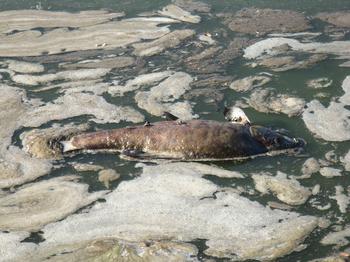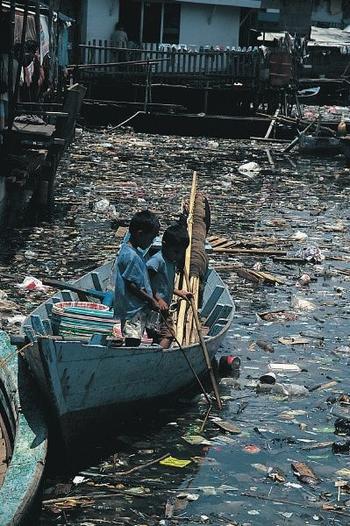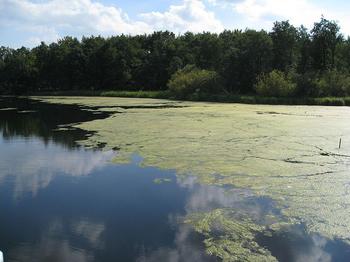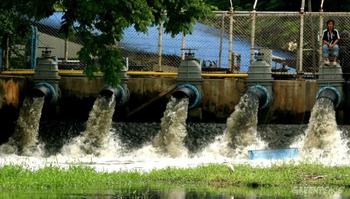Pollutants
Dead fish in polluted lake
Image Credit: Tola69 (2009)
Obvious water pollution
Image Credit: Codrington, S. (2005)
An algae mat on a eutrophied lake in Schleswig-Holstein (Germany)
Image Credit: Maack, S. (2009)
Contaminated waste water pours into a public canal in Thailand from a industrial treatment plant
Image Credit: Greenpeace (2007)
Oxygen-Demanding Substances
Dissolved oxygen is a key element in water quality that is necessary to support aquatic life. A demand is placed on the natural supply of dissolved oxygen by many pollutants in wastewater. This is called biochemical oxygen demand (BOD) and is used to measure how well a sewage treatment plant is working. Organic matter and ammonia are “oxygen-demanding” substances. Oxygen-demanding substances are contributed by domestic sewage and agricultural and industrial wastes of both plant and animal origin, such as those from food processing, paper mills, tanning, and other manufacturing processes.
Pathogens
Infectious microorganisms, or pathogens, may be carried into surface and groundwater by sewage from cities and institutions, by certain kinds of industrial wastes, such as tanning and meat packing plants, and by the contamination of storm runoff with animal wastes from pets, livestock and wild animals, such as geese or deer. Humans may come in contact with these pathogens either by drinking contaminated water or through swimming, fishing, or other contact activities. Modern disinfection techniques have greatly reduced the danger of waterborne disease.
Nutrients
Carbon, nitrogen, and phosphorus are essential to living organisms and are the chief nutrients present in natural water. Large amounts of these nutrients are also present in sewage, certain industrial wastes, and drainage from fertilized land. The release of large amounts of nutrients, primarily phosphorus but occasionally nitrogen, causes nutrient enrichment, which results in an excessive growth of algae. Uncontrolled algae growth blocks out sunlight and chokes aquatic plants and animals by depleting dissolved oxygen in the water at night. The release of nutrients in quantities that exceed the affected waterbody’s ability to assimilate them results in a condition called eutrophication or cultural enrichment. Nitrogen in the form of ammonia can exert a direct demand on oxygen or stimulate the excessive growth of algae. Ammonia in wastewater effluent can be toxic to aquatic life in certain instances. Conventional secondary biological treatment processes do not remove the phosphorus and nitrogen to any substantial extent. In fact, they may convert the organic forms of these substances into mineral form, making them more usable for plants.
Inorganic and Synthetic Organic Chemicals
A vast array of chemicals are included in this category. Examples include detergents, household cleaning aids, heavy metals, pharmaceuticals, synthetic organic pesticides and herbicides, industrial chemicals, and the wastes from their manufacture. Many of these substances are toxic to fish and aquatic life and many are harmful to humans. Some are known to be highly poisonous at very low concentrations.
Thermal
Heat reduces the capacity of water to retain oxygen. In some areas, water used for cooling is discharged to streams at elevated temperatures from power plants and industries. Even discharges from wastewater treatment plants and storm water retention ponds affected by summer heat can be released at temperatures above those of the receiving water and hence, elevate the stream temperature. Unchecked discharges of waste heat can seriously alter the ecology of a lake, a stream or estuary.
(EPA 2004)



